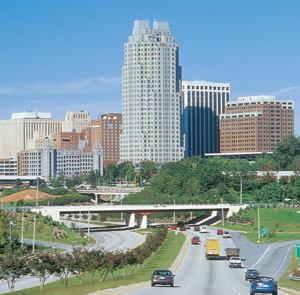Because of the high-income demographics these areas attract, they have historically represented Raleigh‘s lowest vacancy and highest rents—currently at an average of $857 and $823 per month, respectively. However, these two sub-markets alone have 7,369 units proposed or under construction, which is 47 percent of the metro area’s total pipeline. If all of these units were to be delivered as planned, inventory in Northwest Raleigh and the Cary area would increase by 25 percent. With population growth expected to be very strong, it will be interesting to see how long these markets take to absorb the new supply.
One call-out market in this mix is the upscale Brier Creek, a 2,000-acre, mixed-use, master planned Arnold Palmer golf course community located just off of I-540 and Highway 70. In recent months, no fewer than five new multifamily properties have been announced or broken ground in the up-and-coming community. This includes 313 units at Trammell Crow’s Alexan Brier Creek, 350 units at Altman Development Co.’s Highlands, and Phase II construction at both the 300-unit Courtney Estates and the 250-unit Preserve. Indianapolis-based Flaherty & Collins is also building the 274-unit Exchange at Brier Creek. The high-end property, with apartments ranging from 628 square feet to 1,494 square feet, will have rents between $835 and $1,450 per month. Expected to be completed this month, this is one of only a few mid-rise properties in Raleigh, but represents a trend that could take off if rents justify the higher construction costs.
As construction costs and local land prices continue to escalate, developers are seeking economies of scale and other creative ways to make apartment economics work. So, while the majority of new multifamily construction activity in Raleigh consists of mid-size, garden-style complexes, some unique properties like the Exchange are emerging. Another example of this is located near Crabtree Valley Mall, a mature Raleigh neighborhood that is working to re-emerge as a hotspot. In addition to the re-development of the 1966 vintage Beckanna Apartments—one of the few mid-rise multifamily projects in the market—this community will soon welcome the 42-story Soleil Center, which will include both for-sale condominiums and a Westin hotel.
Also being developed in the mall neighborhood is a mixed-use community by York and a high-end infill project by UDR that will set rents in the $900 to $1,400 range. Raleigh’s commercial business district similarly is teeming with activity as a result of growth from employers like Progress Energy, Fidelity Investments, and Quintiles, and from Campbell University, which recently announced the relocation of its law school to downtown Raleigh.
One of the biggest players on the downtown scene is RBC Centura Bank, who has partnered with locally based Highwoods Properties to build a 29-story mixed-use complex that will include office and retail space, plus 10 stories of residential condominiums. When the tower is completed, the bank will move its North American headquarters into the space. Additionally, over the next five years, RBC Centura will contribute $1 million to Raleigh’s downtown development efforts.
The RBC tower is part of approximately 2,800, mostly for-sale condominium units that are in the pipeline in downtown Raleigh. Although the viability of the downtown multifamily market hasn’t been significantly tested, initial response to the first units on the ground has been good. At the RBC building, for example, it is reported that all 228 units must have nonrefundable deposits before the project can be completed.
CAPITAL IDEAS As interest rates continue to adjust, the next big issue facing Raleigh may be the credit crunch. As is historically the case, the rising cost of capital will place downward pressure on local apartment values. Lenders report that the cost of money has increased across all classes of property and more so on Class B and C properties. As a result, returns become harder to achieve, which raises Class A properties to the preferred list as compared to Class B and C properties, which likely will experience the greatest correction in price. The good news is that an abundance of capital is still available, albeit at slightly different terms.
Yet whether values and returns remain the same or drop slightly, it boils down to this: Raleigh is a dynamic and sound marketplace that is well ahead of many other U.S. markets. Quality of life is good and jobs are available, so people continue to move here from all parts of the United States. And those elements make this multifamily sector good. As the old saying about pizza goes, even when it’s “bad,” it’s still really, really good.
Scott Busch is a senior advisor with Sperry Van Ness.
FAST FACTS
Considering Raleigh, N.C.? Here’s what you need to know:
- Population: 1.5 million
- Occupancy: 92 percent
- Median Age: 32 years
- Median Household Income: $62,705
- Average Rent: $0.84 per square foot per month
Unemployment: 3.4% NOTABLE: Raleigh is known as the “City of Oaks” and often is described as “a park with a city in it.” Greater Raleigh is home to several major institutions of higher learning, five of which date back to the 19th century. North Carolina became the nation’s first state to provide continuing financial support for an orchestra: The North Carolina Symphony.
